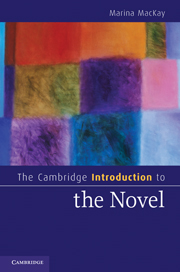Book contents
- Frontmatter
- Contents
- Acknowledgments
- About this book
- Chapter 1 Why the novel matters
- Miguel de Cervantes, Don Quixote (1605, 1615)
- Chapter 2 Origins of the novel
- Laurence Sterne, The Life and Opinions of Tristram Shandy, Gentleman (1759–67)
- Chapter 3 Narrating the novel
- James Hogg, The Private Memoirs and Confessions of a Justified Sinner (1824)
- Chapter 4 Character and the novel
- Nathaniel Hawthorne, The Scarlet Letter (1850)
- Chapter 5 Plotting the novel
- Gustave Flaubert, Madame Bovary (1857)
- Chapter 6 Setting the novel
- Charles Dickens, Bleak House (1853)
- Chapter 7 Time and history
- Virginia Woolf, To the Lighthouse (1927)
- Chapter 8 Genre and subgenre
- Graham Greene, The Ministry of Fear (1943)
- Chapter 9 Novel and anti-novel
- Thomas Pynchon, The Crying of Lot 49 (1966)
- Chapter 10 Novel, nation, community
- Salman Rushdie, Midnight's Children (1981)
- Chapter 11 Concluding
- Notes
- Glossary
- Further reading
- Index
- Cambridge Cultural Social Studies
Miguel de Cervantes, Don Quixote (1605, 1615)
Published online by Cambridge University Press: 05 June 2012
- Frontmatter
- Contents
- Acknowledgments
- About this book
- Chapter 1 Why the novel matters
- Miguel de Cervantes, Don Quixote (1605, 1615)
- Chapter 2 Origins of the novel
- Laurence Sterne, The Life and Opinions of Tristram Shandy, Gentleman (1759–67)
- Chapter 3 Narrating the novel
- James Hogg, The Private Memoirs and Confessions of a Justified Sinner (1824)
- Chapter 4 Character and the novel
- Nathaniel Hawthorne, The Scarlet Letter (1850)
- Chapter 5 Plotting the novel
- Gustave Flaubert, Madame Bovary (1857)
- Chapter 6 Setting the novel
- Charles Dickens, Bleak House (1853)
- Chapter 7 Time and history
- Virginia Woolf, To the Lighthouse (1927)
- Chapter 8 Genre and subgenre
- Graham Greene, The Ministry of Fear (1943)
- Chapter 9 Novel and anti-novel
- Thomas Pynchon, The Crying of Lot 49 (1966)
- Chapter 10 Novel, nation, community
- Salman Rushdie, Midnight's Children (1981)
- Chapter 11 Concluding
- Notes
- Glossary
- Further reading
- Index
- Cambridge Cultural Social Studies
Summary
As God slowly departed from the seat whence he had directed the universe and its order of values, distinguished good from evil, and endowed each thing with meaning, Don Quixote set forth from his house into a world he could no longer recognize. In the absence of the Supreme Judge, the world suddenly appeared in its fearsome ambiguity; the single divine Truth decomposed into myriad relative truths parceled out by men. Thus was born the world of the Modern Era, and with it the novel, the image and model of that world.
Milan Kundera, “The Depreciated Legacy of Cervantes”I wrote above that no one would be foolish enough to model their behavior on the unrealistic old romance, but a famous exception comes in the most important early novel of all: Cervantes's Don Quixote, published in two parts in 1605 and 1615, a novel in which a middle-aged Spanish farmer saddles up his scrawny workhorse and sets off to put the world to rights in the heroic style of his beloved chivalric romances. Turned into something close to parody by their incongruence with the hero's own prosaic world, the extravagant conventions of chivalric romance seem to give way to the representation of reality in all its ordinariness. Did Don Quixote represent the triumph of modernity and reason? Did Cervantes liberate fiction from fantasy and falsity? Perhaps – but the novel speaks more ambivalently than this about the value of disenchantment.
- Type
- Chapter
- Information
- The Cambridge Introduction to the Novel , pp. 16 - 20Publisher: Cambridge University PressPrint publication year: 2010

